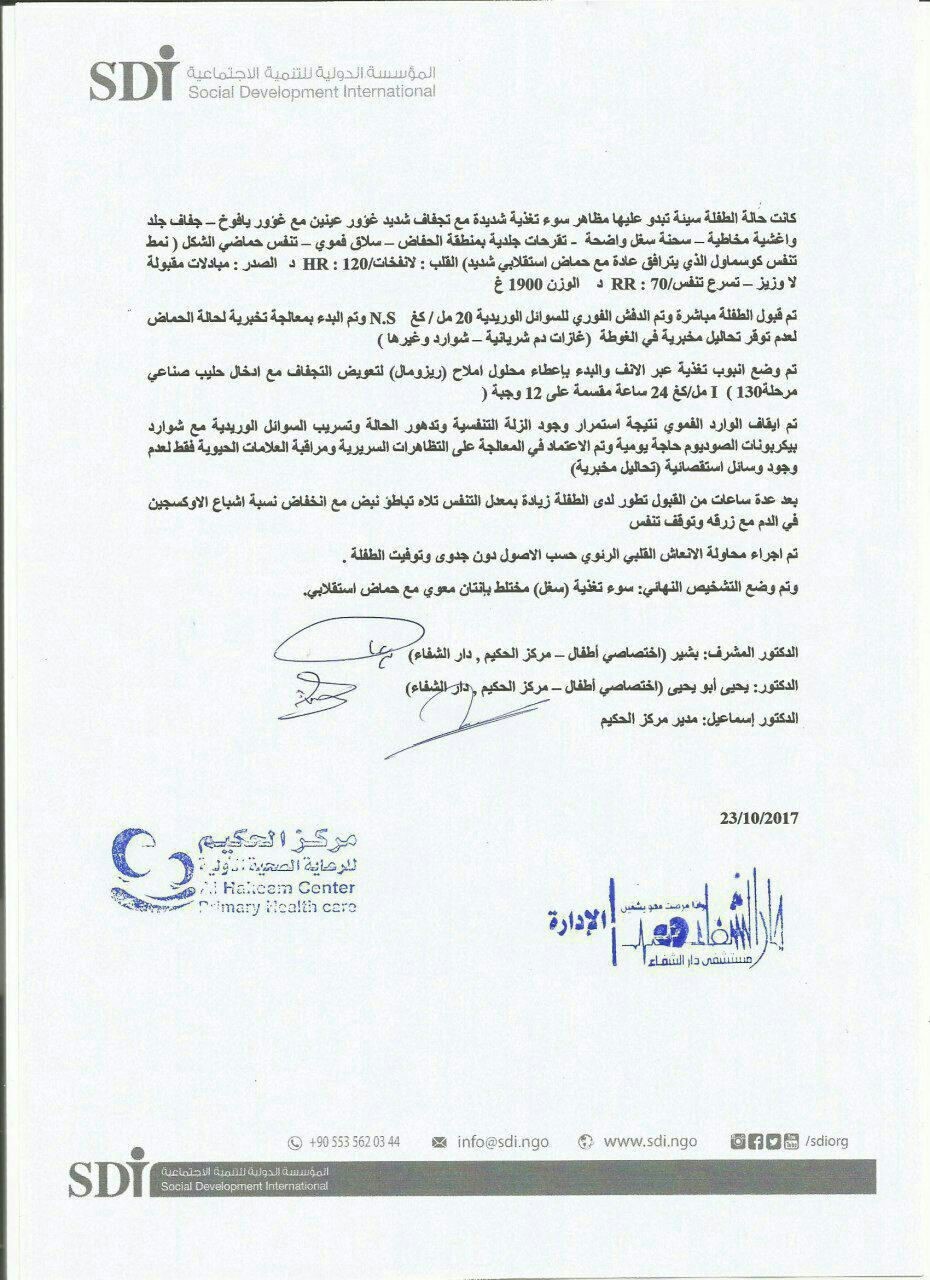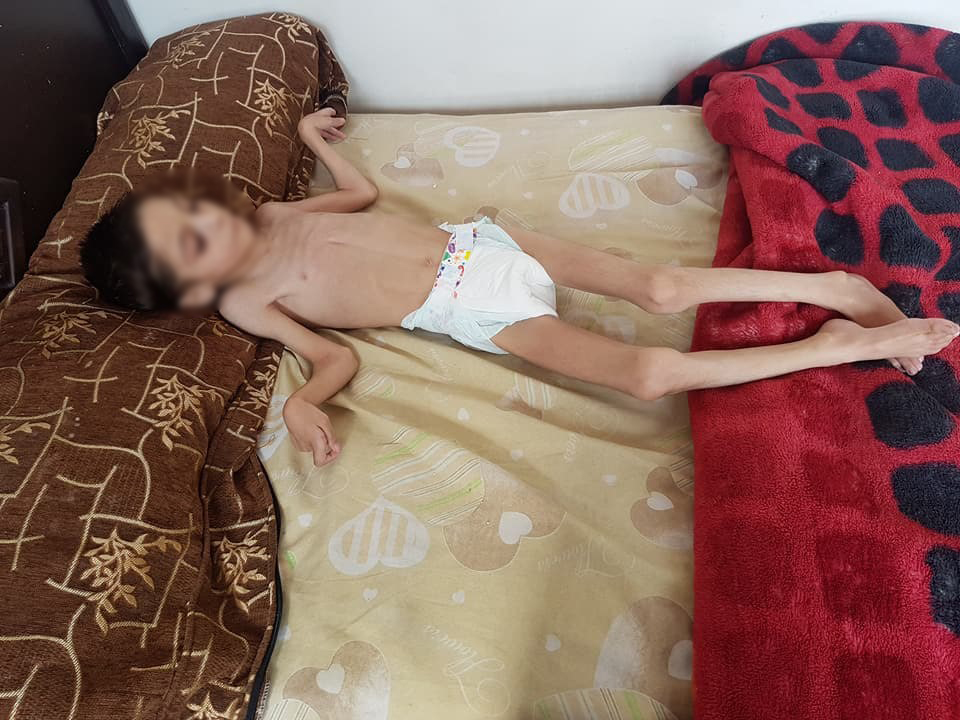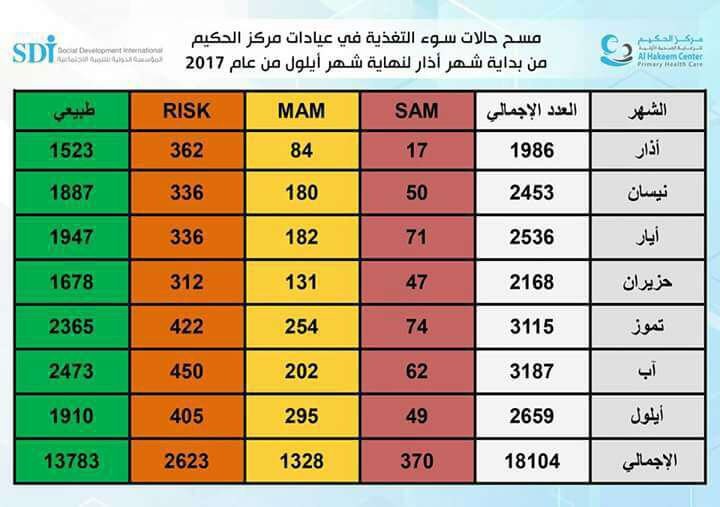Preface: The siege imposed on Eastern Ghouta several years ago continues to threaten the lives of thousands of civilians trapped by Syrian regular forces, especially children and women. Numbers of the malnourished[1] children have doubled, since 2017 as the blockade has intensified after all tunnels, which connect the capital, Damascus, with cities and towns of Eastern Ghouta, got out of service as a result of heavy military battles, besides the block of the entry of all foodstuffs and medical supplies.
According to many testimonies obtained by Syrians for Truth and Justice (STJ) in November 2017, around 150 children were diagnosed with Malnutrition during 2017 alone, while no accurate information is available to date on the number of children who died from the disease. However, STJ reporter referred to the death of four children from Malnutrition during October and November 2017, including the girl children Sahar Difda’a and Sarah from Hamoryah city and the boy child Mohammed Abdul Salam.
“I Just Stood There Helpless Watching My Child Dying”
The girl child "Sahar Difda’a" from Kafr Batna town, died only after 34 days of her birth, specifically on October 22, 2017, after she was diagnosed with Malnutrition, caused by the severity of the siege on Eastern Ghouta, in addition to the bad financial situation of the girl's family, which was confirmed by Sahar’s father, Mohammed who spoke to STJ saying:
"My daughter was born with a weak constitution, as a result of shortage of food her mother had already suffered from. It is my daughter’s fate to be born under the severe blockade we are subjected to. We tried by various means to save her life but to no avail, we were not even able to find food for her mother so that she could breastfeed her. My daughter’s life could have been saved if she had got a little bit of care, but I couldn't do anything since I don't have enough money, and I cannot afford my wife and my daughter’s needs. I stood helpless watching my daughter dying in front of my eyes."
Sahar’s father said that his daughter stayed at Al-Hakeem Medical Centre, in Kafr Batna town, for 15 days to receive treatment, where the medical staff made every effort to save her life, but she was breathing heavily, in her short days, her body was scrawny and her bones were clearly visible, she weighed less than 2 kg, he continued:
"All I pray for is that no other children go through the suffering my daughter had endured and resulted to the loss of her life, there are no words that can describe the tragedy we have experienced."
A video footage published by the Syrian Media Organization on October22, 2017 showed the girl child Sahar Difda’a in scrawny body and clear bones, suffering from Malnutrition and Dyspnea.

 Image shows the girl child Sahar Difda’a prior to her death on October.22.2017, as a result of severe malnutrition under the intensified siege on Eastern Ghouta,
Image shows the girl child Sahar Difda’a prior to her death on October.22.2017, as a result of severe malnutrition under the intensified siege on Eastern Ghouta,
Photo credit: Syrian Media Organization.
In turn, Al-Hakeem Medical Centre located in Kafr Batna town, as it oversaw her treatment, published a statement on October 24, 2017, in which it explained the situation of the girl child, Sahar Difda’a and her death from Malnutrition, it also indicated the poor financial situation and poverty her family suffers, which exacerbated by the blockade imposed on Eastern Ghouta.


Image shows the statement issued by Al-Hakeem Medical Centre, where the child Sahar had been treated prior her death on October22, 2017, in which it explained the situation of the girl child and the causes leading to her death.
Photo credit: Ghouta Media Centre’s Facebook page.
"She is Still Struggling to Survive with her Scrawny Body and Weak Structure"
The girl child "Rahaf Hawwa" who has not yet exceeded eight years, from Douma city, has also been diagnosed with Malnutrition since 2016. All attempts to treat her in and outside Eastern Ghouta failed which has caused her health situation to deteriorate, and still until this moment she is struggling to survive with a scrawny body and a weak structure.
In this regard, Ali Hawwa, grandfather of the child, has spoken to STJ, saying:
"Several years ago, Rahaf was a normal child, but she has suffered several tragedies in 2016, as a missile landed on her family’s house in Douma city, fired by Syrian regime forces, which resulted in the death of her younger sister, grandmother and her uncle. That led to a deterioration in her psychological state, besides that her father had died when she was only two years old, she tasted the bitterness of early orphanhood. When Rahaf was diagnosed with Malnutrition, her family tried by various means to secure treatment and feed her properly, they also tried to take her out to receive treatment in Damascus hospitals, but all their attempts failed as a result of the siege imposed on Eastern Ghouta. Suffering of my granddaughter Rahaf increased with the intensification of the blockade, specifically seven months ago, due to the block of the entry of food and medicine. Now we can do nothing but pray, I am afraid of that day in which we will bid farewell Rahaf doing nothing to help her survive.


Image shows the child Rahaf Hawa, one of the children diagnosed with Malnutrition in Eastern Ghouta, in a scrawny body and clear bones
Photo credit: Douma Coordination’s Facebook page.
“150” Children Diagnosed with Malnutrition in 2017 Alone
According to STJ reporter, several medical centres in Eastern Ghouta have conducted statistics showing the proportion of children with Malnutrition, including Al-Hakeem Centre for primary health care, which published statistics showing the increase in the proportion of children with Malnutrition from March to September 2017. The number of borderline Malnutrition cases (on Risk table) (approx. 2623) case, and the number of cases of children with moderate Malnutrition (on Man table) (approx.1328) case, while children suffering from severe Malnutrition (on Sam table) (approx.370) child.

Image shows statistic conducted by Al-Hakeem Centre for primary health care in Eastern Ghouta, on the proportions of malnourished children from March to September 2017
Photo credit: Al-Hakeem Medical Centre’s Facebook page
The population of Eastern Ghouta is about 400 thousand civilians, consist of 90 thousand families, and about 25 thousand children under two years of age. Most of whom are under suffocating siege and the spectre of hunger. That was confirmed by Mohammed al-Dalati, a board member of Charity Health Society in Douma city, who spoke to STJ saying:
"A large proportion, which may reach 70%, of Eastern Ghouta’s children likely to be malnourished or have borderline malnutrition. Our health care centre counted about (150) cases of children suffering from severe Malnutrition during 2017 alone. However, there are no accurate statistics, at the level of Ghouta, estimate the number of children suffering from Malnutrition or even ones who died from it, due to the constant displacement of people from one place to another. It is important to point out that Malnutrition often accompanies with other factors, such as the lack of medication and the poor psychological condition of children as a result of war and siege, as well as the severe contamination of water which has spread in Eastern Ghouta recently. Let alone the high prices of food items, the price of one-bread bundle exceeded four dollars, which is an essential food for Eastern Ghouta people, who most of them cannot find a job."
Al-Dalati noted that Malnutrition is not only affecting children, but also many mothers, especially in pregnancy, explaining that many children died as soon as they were born, because their mothers were unable to breastfeed them as a result of their suffering from the severe Malnutrition caused by the siege on Eastern Ghouta.
It is worth mentioning that on May 4, 2017, sponsor states of Astana Talks (Russia, Turkey and Iran) signed a Memorandum of Understanding for establishment of de-escalation zones in Syria. It included Eastern Ghouta in Damascus countryside, Idlib province and some parts of northern Homs, as well as some parts of adjacent provinces (Latakia, Hama, and Aleppo) and some parts of southern Syria. One of the most prominent items is cessation of hostilities between conflicting parties and creation conditions for access medical aids.
The last aid convoy entered Eastern Ghouta was on November12, 2017, according to STJ reporter.
On July 22, 2017, the Army of Islam participated in signing de-Escalation Agreement in Syria, followed by Failaq al-Rahman, on August 18, 2017.
STJ, had earlier prepared a report highlighting the suffering of many patients trapped in Eastern Ghouta waiting to be evacuated and taken out to Damascus hospitals for treatment. And it has also prepared another report on the suffering of the chronically ill persons during four years of siege on Eastern Ghouta.
[1] According to a doctor from Eastern Ghouta interviewed by Syrians for Truth and Justice/STJ reporter in November 2017, Malnutrition commonly occurs when someone does not eat enough food and it can result from the lack of balanced food.

